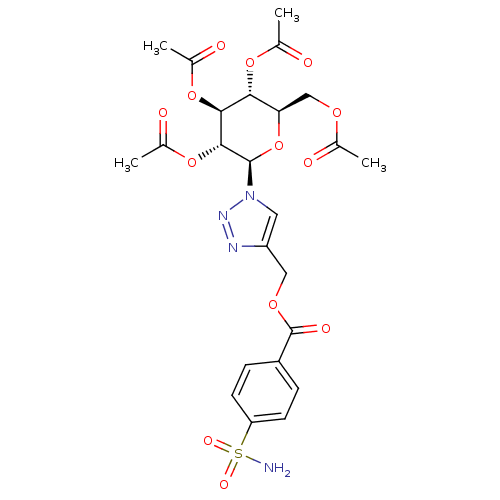BDBM12920 4-({[4-(Aminosulfonyl)benzoyl]oxy}methyl-1-(2,3,4,6-tetra-O-acetyl-beta-D-glucopyranosyl)-1H-1,2,3-triazole::CHEMBL383897::Glycoconjugate Benzene Sulfonamide 3a::{1-[(2R,3R,4S,5R,6R)-3,4,5-tris(acetyloxy)-6-[(acetyloxy)methyl]oxan-2-yl]-1H-1,2,3-triazol-4-yl}methyl 4-sulfamoylbenzoate
SMILES CC(=O)OC[C@H]1O[C@H]([C@H](OC(C)=O)[C@@H](OC(C)=O)[C@@H]1OC(C)=O)n1cc(COC(=O)c2ccc(cc2)S(N)(=O)=O)nn1
InChI Key InChIKey=VLTLYBSKNONSPK-XNBWIAOKSA-N
Data 9 KI
Activity Spreadsheet -- Enzyme Inhibition Constant Data from BindingDB
 Found 9 hits for monomerid = 12920
Found 9 hits for monomerid = 12920
Affinity DataKi: 7.70nMAssay Description:Inhibition of human recombinant CA12 by stopped flow CO2 hydration assayMore data for this Ligand-Target Pair
Affinity DataKi: 7.70nMAssay Description:Inhibition of human recombinant CA12 by CO2 hydration assayMore data for this Ligand-Target Pair
Affinity DataKi: 119nMAssay Description:Inhibition of human recombinant CA2 by stopped flow CO2 hydration assayMore data for this Ligand-Target Pair
Affinity DataKi: 119nMAssay Description:An Applied Photophysics stopped-flow instrument has been used for assaying the CA-catalyzed CO2 hydration activity. Phenol red has been used as indic...More data for this Ligand-Target Pair
Affinity DataKi: 123nMAssay Description:Inhibition of human recombinant CA14 by CO2 hydration assayMore data for this Ligand-Target Pair
Affinity DataKi: 1.24E+3nMAssay Description:Inhibition of human recombinant CA9 by stopped flow CO2 hydration assayMore data for this Ligand-Target Pair
Affinity DataKi: 1.24E+3nMAssay Description:An Applied Photophysics stopped-flow instrument has been used for assaying the CA-catalyzed CO2 hydration activity. Phenol red has been used as indic...More data for this Ligand-Target Pair
Affinity DataKi: 2.30E+3nMAssay Description:Inhibition of human recombinant CA1 by stopped flow CO2 hydration assayMore data for this Ligand-Target Pair
Affinity DataKi: 2.30E+3nM ΔG°: -7.69kcal/molepH: 7.5 T: 2°CAssay Description:An Applied Photophysics stopped-flow instrument has been used for assaying the CA-catalyzed CO2 hydration activity. Phenol red has been used as indic...More data for this Ligand-Target Pair
